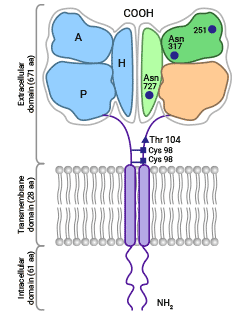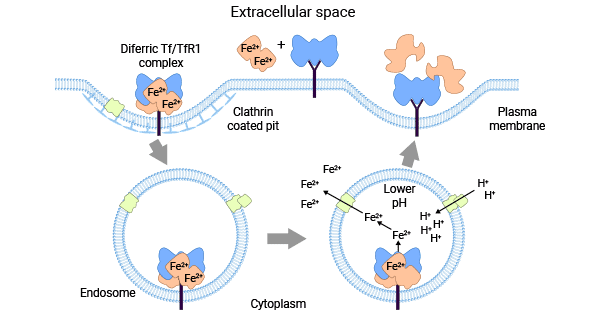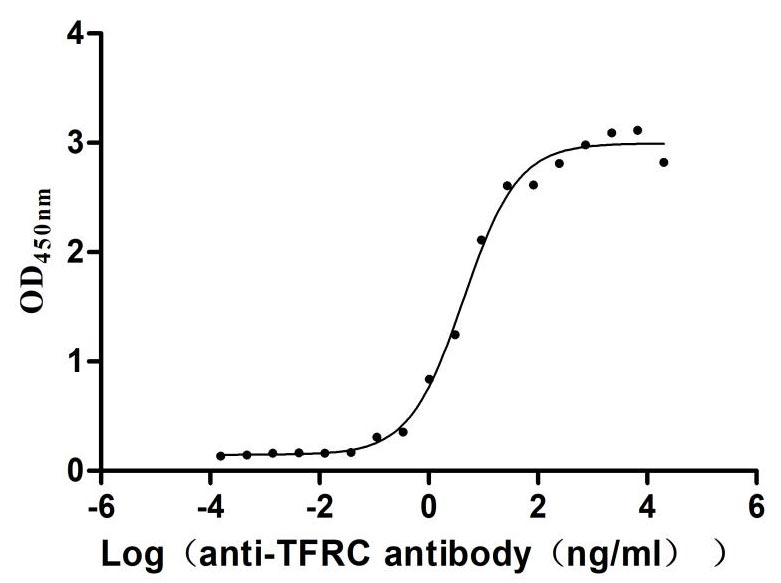转铁蛋白受体TFR1(TFRC):铁稳态关键成员,贫血、神经退行性疾病、癌症新锐靶点!
日期:2023-06-25 16:01:31
转铁蛋白受体TFR1是介导铁离子进入细胞通道的关键成员之一,在调节细胞铁代谢和维持铁平衡中发挥关键作用。细胞铁缺乏可以抑制细胞生长,从而导致细胞死亡。但当细胞癌变,则需要大量的铁才能维持较高的细胞增殖率,过量的铁将促进肿瘤发展。铁代谢异常已被认为是肿瘤的特异性标记之一。
现有研究证实,TFR1在许多肿瘤细胞中高表达,成为了潜在的肿瘤标志物,且针对TFR1进行治疗可以有效地抑制肿瘤生长和转移。此外,TFR1还与其它疾病如贫血、铁代谢障碍性疾病等有关。因此,以TFR1为靶点的治疗策略来靶向调节细胞内铁水平,有望在相关疾病的临床应用中发挥重要作用。
1. 什么是TFR1?
1.1 TFR1的结构
转铁蛋白受体1(Transferrin receptor protein 1,TFR1)也被称为CD71或TFRC。TFR1/TFRC是一种II型跨膜蛋白,是调节细胞内铁元素转运过程的最重要膜蛋白。TFR1是由两个同源二聚体的亚基通过二硫键交联而成。每个单体包含一个大的胞外C端区域,一个单跨膜区域及一个短的N端区域。C端区域作为外功能区,包含了与转铁蛋白(Transferrin,Tf)相结合的位点(图1) [1-3]。目前已发现两种转铁蛋白受体,分别是TFR1和TFR2,它们在结构和功能上都比较相似。在正常生理条件下,TFR1与转铁蛋白Tf发生相互作用,促进铁的吸收。这种结合形式是血液中铁的主要存在方式 [4-5]。

图1. TFR1的结构 [1]
1.2 TFR1的表达
TFR1是一种广泛表达于人体几乎所有细胞和组织类型中的膜蛋白。TFR1在人体需要铁元素时发挥作用,介导铁离子的转运和代谢。TFR1的表达广泛分布于免疫系统、造血系统(如骨髓干细胞、红细胞和白细胞)、神经系统(如神经元和神经胶质细胞)、生殖系统、心脏、肝脏、肾脏等各种组织和细胞类型。TFR1的表达水平受多种因素影响,包括细胞内铁含量、细胞分化状态、激素调节以及炎症状态等 [6-8]。
1.3 TFR1的功能
TFR1最主要的生理功能是与转铁蛋白(transferrin,Tf)结合,通过内吞方式介导细胞对铁的摄取。因此,Tf-TFR1系统被认为是机体获取铁离子的重要途径。具体而言,首先,Tf和铁离子(Fe3+或Fe2+形式)结合后,其空间结构随之发生相应变化,将铁离子包入蛋白内形成Tf-Fe2+。其次,TFR1在生理pH下与Tf-Fe2+结合,Tf-TFR1复合物被网格蛋白(Clathrin)通过小窝的内吞作用内部化(图2) [9-11]。
随之,胞内Tf-TFR1复合物被运输至内体酸化,TFR1和Tf的氨基酸残基相互作用,引起构象改变促使铁离子释放,TFR1通过高尔基复合体循环至细胞表面完成铁离子运输。总之,TFR1在细胞和组织中扮演着重要角色,通过TFR1的调节来平衡细胞内铁含量,维持人体铁稳态是保证人体各项生理机能正常运作的必要条件 [9-11]。

图2. Tf-TFR1系统平衡细胞内铁含量 [1]
2. TFR1相关的调控机制
TFR1是细胞最重要的铁元素摄取因子。TFR1表达量下降或异常会导致细胞缺铁,而过多的铁则可能催化活性氧(ROSs)并损伤生物大分子。为了确保充足的铁元素同时避免其毒性,细胞已经发展出多种机制来调控TFR1表达水平。尽管TFR1异常表达在多种疾病中发挥作用,但其分子机制和作用仍未完全明确。因此,还需要更深入地研究和探索。
TFR1的表达受多种刺激条件调控。在转录水平中,当细胞发生缺氧时,缺氧诱导因子(HIF)和其他转录因子如c-Myc、GATA1、Ets-1以及促红细胞生成素Stat5可以促进其转录。TFR1的转录后水平主要由IRP1和IRP2调控,它们与TFR1 mRNA中的IRE结合来影响基因表达 [12-14]。
在翻译后水平,CD133(PROM1)是TFR1转运铁元素过程中的负调节因子,同时EGF受体、c-Abl分子和MARCH8分子可能也参与其中。如下图所示,一项研究揭示FLCN有可能在翻译、或者翻译后水平调控TFR1的表达,即Tf-TFR1复合物可与含有Rab11蛋白的循环内体相结合,回到细胞膜上(图3)[12-16]。
TFR1在疾病中发挥调控作用。例如,在胶质瘤中,TFR1通过炎症反应,细胞周期,DNA损失及DNA甲基化等机制参与胶质瘤的发生发展。此外,PD1信号,如IL17,IL18,NF-kβ,FOXM1,FOCAL及JAK-STAT信号可能是TFR1调控的关键信号通路 [17-19]。在神经干细胞中敲除TFR1发现,条件性敲除小鼠有癫痫的症状。并且在此研究中还发现GluA2在海马神经元突触上表达增加,其中突触前的神经递质释放能力下降,突触后长时程增强(LTP)受到一定的抑制 [20-22]。

图3. FLCN通过Rab11A调控Tf-TFR1蛋白的回收运输 [16]
3. TFR1在肿瘤、神经退行性等疾病中的作用
正常人体铁代谢处于平衡状态,当其中的某一调控环节出现异常导致平衡被打破时,会影响细胞内自由基形成并加速氧化应激反应进展,同时也可导致肿瘤发生和发展。TFR1作为细胞摄取铁元素过程中最重要的调控受体,在多种疾病的发生发展过程中起到重要作用。
3.1 TFR1和肿瘤
现有研究表明TFR1在甲状腺癌 [23]、食管鳞状细胞癌 [24]、乳腺癌 [25]、肝癌 [26]、结肠癌 [27]、白血病 [28]、肺癌 [29]、胰腺癌 [30]、鼻咽癌 [30]等恶性肿瘤中显著表达。但在部分恶性肿瘤中,TFR1表达情况尚不明确,其中包括:前列腺癌、睾丸癌等。例如,在肝癌中,TFR1在肝癌中的表达与甲胎蛋白和血清凝血酶原的浓度有关 [26];在乳腺癌中,敲降IRP2表达,可提高铁蛋白重链的表达,并下调TFR1蛋白表达,从而抑制乳腺癌细胞的生长 [25, 31];在结肠癌中,TFR1的高表达可激活IL-6/IL-11-Stat3信号通路,促进结肠上皮细胞的增殖和凋亡,从而加重结肠黏膜的损伤并导致结肠癌的发生 [27, 32]。
3.2 TFR1和神经退行性疾病
铁代谢的紊乱是引发神经退行性疾病的病理生理机制之一。铁在大脑中的蓄积,与阿尔茨海默病、帕金森病、肌萎缩侧索硬化等神经退行性疾病有关 [33]。阿尔茨海默病是最常见神经退行性疾病之一,其主要以淀粉样斑块的积聚以及某些神经元的丢失为发病特征。有研究表明,抑制阿尔兹海默模型小鼠大脑颞叶皮层中的铁摄取蛋白TFR1、TF以及DMT1的表达,可有效缓解铁过载状态 [34-35]。
3.3 TFR1和贫血
TFR1与Tf复合物的结合,对红细胞生成过程中细胞获取铁元素有着重要意义。当人体内发生缺铁或者红细胞生成增多时,TFR1的表达将被反应性上调。临床研究证实,地中海贫血小鼠体内的溶性转铁蛋白受体(sTFR1)和TF的水平都显著高于正常值。进一步研究揭示,TFR1在β-地中海红系前体细胞中异常高表达,降低TFR1的表达可有效调节贫血小鼠中无效红细胞的生成并改善小鼠的贫血以及铁过载情况 [6, 36]。
3.4 TFR1和其它疾病
TFR1不仅参与细胞铁离子运输,有研究提示TFR1还可作为多种病毒受体介导HCV与宿主细胞膜融合,在HCV入胞过程中发挥重要作用。丙型肝炎病毒(HCV)是导致慢性化肝炎、原发性肝癌的主要病原体。因此,TFR1作为HCV抗病毒靶点的潜在可能性值得关注 [37-39]。在神经元中,研究发现TFR1对mGlul的转运起到重要的调节作用,并且可能参与了mGlul信号通路,且对小脑的运动协调能力起到影响 [40-41]。
4. TFR1的临床在研药物
目前已有多款针对转铁蛋白受体1(TFR1)的临床药物正在研发中(表1),这些药物主要用于贫血、铁代谢障碍性疾病、感染、神经退行性疾病、癌症等治疗。其中,PPMX-T003、CX-2029、DYNE-251和Trontinemab等药物已处于临床1/2期。近年来,基于TFR1的靶向治疗策略在不断发展。有研究利用TFR1提高抗体跨越血脑屏障的转运能力,并与抗β-淀粉样肽单抗相结合形成特异性复合抗体,以提高阿尔茨海默病患者的治疗效果 [42-43]。
同时,抗TFRC的抗体JST-TFR09和抗TFRC单克隆抗体A24分别可抑制肿瘤细胞对铁元素的摄取,以及诱导T系细胞白血病中恶性细胞的凋亡 [44-45]。这些研究提示,TFR1有望成为有效的靶标分子参与到多种疾病的临床治疗。未来,随着TFR1相关研究的不断深入和完善,有望为患者提供更加精准、有效的治疗,为他们带来更多的获益和新希望。
| 药物 | 靶点 | 作用机制 | 在研适应症 | 药物最高研发状态(全球) | 药物类型 | 在研机构 |
|---|---|---|---|---|---|---|
| Human apotransferrin(Prothya Biosolutions) | TFR2 + TFR1 | TFR2激动剂、TFR1刺激剂 | 先天性无转铁蛋白血症;β地中海贫血 | 临床2/3期 | 蛋白类药物 | Prothya Biosolutions Netherlands |
| PPMX-T003 | TFR1 | TFR1拮抗剂 | 大颗粒淋巴细胞白血病;真性红细胞增多症 | 临床1/2期 | 未知 | 株式会社英仙蛋白质科学 Perseus Proteomics, Inc.; 广岛大学 Hiroshima University; 学校法人东海大学 Tokai University |
| CX-2029 | TFR1 | TFR1拮抗剂 | 弥漫性大B细胞淋巴瘤;食管癌;非小细胞肺癌 | 临床1/2期 | 单克隆抗体;ADC | 西托姆克斯治疗公司 CytomX Therapeutics, Inc. |
| DYNE-251 | TFR1 | TFR1拮抗剂、RNA干扰 | 杜氏肌营养不良症 | 临床1/2期 | 反义寡核苷酸 | Dyne Therapeutics, Inc. |
| Trontinemab | APP+TFR1 | APP抑制剂、TFR1拮抗剂 | 阿尔茨海默病 | 临床1/2期 | 双特异性抗体 | F. Hoffmann-La Roche Ltd. |
| INA-03 | TFR1 | TFR1拮抗剂 | 急性双表型白血病、急性髓性白血病、急性淋巴细胞白血病 | 临床1期 | 生物药 | 英納特利斯 Inatherys SAS; 尚波立及愛琳卡默茲中心 Institut Jean Paoli & Irene Calmettes |
| Delpacibart Etedesiran | TFR1 | TFR1拮抗剂 | / | 临床阶段不明 | 抗体核酸偶联药物 | / |
| Delpacibart | TFR1 | TFR1拮抗剂 | / | 临床阶段不明 | 单克隆抗体 | / |
| FORCE-M23D | TFR1 + Dystrophin | TFR1拮抗剂、Dystrophin抑制剂 | 良性假肥大性肌营养不良症 | 临床申请 | 抗体核酸偶联药物 | Dyne Therapeutics, Inc. |
| TXB4-BC1 | CD20 + TFR1 | CD20抑制剂、TFR1拮抗剂 | 淋巴瘤 | 临床前 | 双特异性抗体 | Ossianix, Inc. |
| TXB4-BC3 | PDL1 + TFR1 | PDL1抑制剂、TFR1拮抗剂 | 胶质母细胞瘤 | 临床前 | 双特异性抗体 | Ossianix, Inc. |
| FORCE-FM10 | DUX4 + TFR1 | DUX4抑制剂、TFR1拮抗剂 | 1a型面肩肱型肌营养不良症 | 临床前 | 抗体核酸偶联药物 | Dyne Therapeutics, Inc. |
| INA-01 | TFR1 | TFR1拮抗剂 | 肿瘤 | 临床前 | 单克隆抗体 | 英納特利斯 Inatherys SAS |
| PGT (OncBioMune) | TFR1 | TFR1刺激剂 | 肾肿瘤、肺癌、卵巢癌 | 临床前 | 生物药 | Theralink Technologies, Inc.; 昂克拜慕恩有限责任公司 OncBioMune, Inc. |
| TXB4-BC2 | EGFRvIII + TFR1 | EGFRvIII拮抗剂、TFR1拮抗剂 | 胶质母细胞瘤 | 临床前 | 双特异性抗体 | Ossianix, Inc. |
| Bicycle oligonucleotide therapeautics(Bicycle Therapeutics) | TFR1 | TFR1拮抗剂 | 神经肌肉疾病 | 临床前 | 寡核苷酸 | 拜斯科医疗有限公司 Bicycle Therapeutics Plc; Ionis Pharmaceuticals, Inc. |
| Rutherrin | TFR1 | TFR1拮抗剂 | 胶质母细胞瘤、非小细胞肺癌 | 临床前 | 未知 | 锡拉莱斯科技有限公司 Theralase Technologies, Inc. |
| KB-121 | TFR1 | TFR1拮抗剂 | 伯基特淋巴瘤、弥漫性大B细胞淋巴瘤、高级别B细胞淋巴瘤、套细胞淋巴瘤、多发性骨髓瘤 | 临床前 | 单克隆抗体 | Gemopharm OOO |
| TE-5200 | CD49d + TFR1 | CD49d拮抗剂、TFR1拮抗剂 | 多发性硬化症 | 药物发现 | 双特异性抗体 | 免疫功坊股份有限公司 Immunwork, Inc. |
| TE-5126 | CB + EDG6 + SIPR1 + SIPR2 + SIPR3 + TFR1 | CB拮抗剂+EDG6调节剂+SIPR1调节剂+SIPR2调节剂+SIPR3调节剂+TFR1拮抗剂 | 多发性硬化症 | 药物发现 | 单克隆抗体;ADC | 免疫功坊股份有限公司 Immunwork, Inc. |
| TE-5300 | APP + TFR1 | APP抑制剂、TFR1拮抗剂 | 阿尔茨海默病 | 药物发现 | 双特异性抗体 | 免疫功坊股份有限公司 Immunwork, Inc. |
| TXB4-LS1 | IDUA + TFR1 | IDUA inhibitor、TFR1拮抗剂 | 黏多糖贮积症I型 | 药物发现 | 融合蛋白 | Ossianix, Inc. |
| Monoclonal antibody 42/6 | TFR1 | TFR1拮抗剂 | / | 临床1期 | 单克隆抗体 | / |
| MAT-201 | TFR1 | TFR1拮抗剂 | / | 药物发现 | 单克隆抗体 | / |
| Lysosomal storage disease therapeutics (bioOasis) | TFR1 | TFR1调节剂、酶替代物 | / | 药物发现 | 酶;偶联药物 | / |
| Anti-CD19 monoclonal antibody-liposomal sodium butyrate conjugate | TFR1 | TFR1拮抗剂 | / | / | 单克隆抗体;ADC | / |
表1:TFR1的临床在研药物
为鼎力协助各药企针对TFR1在贫血、铁代谢障碍性疾病、感染、神经退行性疾病、癌症等临床中的研究,CUSABIO推出TFR1活性蛋白产品(Code: CSB-MP3648HU),助力您在TFR1机制方面的研究或其潜在临床价值的探索。
Recombinant Human Transferrin receptor protein 1(TFRC),partial (Active) (Code: CSB-MP3648HU)

High specificity was validated by SDS-PAGE. SDS-PAGE (reduced) with 5% enrichment gel and 15% separation gel.

Immobilized Human TFRC at 2μg/mL can bind Anti-TFRC recombinant antibody (CSB-RA023441MA1HU), the EC50 is 3.305-8.220 ng/mL.
参考文献:
[1] Candelaria, Pierre V., et al. "Antibodies targeting the transferrin receptor 1 (TfR1) as direct anti-cancer agents." Frontiers in immunology 12 (2021): 607692.
[2] Jabara, Haifa H., et al. "A missense mutation in TFRC, encoding transferrin receptor 1, causes combined immunodeficiency." Nature genetics 48.1 (2016): 74-78.
[3] Greene, Christopher J., et al. "Transferrin receptor 1 upregulation in primary tumor and downregulation in benign kidney is associated with progression and mortality in renal cell carcinoma patients." Oncotarget 8.63 (2017): 107052.
[4] Kawabata, Hiroshi. "Transferrin and transferrin receptors update." Free Radical Biology and Medicine 133 (2019): 46-54.
[5] Kleven, Mark D., Shall Jue, and Caroline A. Enns. "Transferrin receptors TfR1 and TfR2 bind transferrin through differing mechanisms." Biochemistry 57.9 (2018): 1552-1559.
[6] Li, Huihui, et al. "Decreasing TfR1 expression reverses anemia and hepcidin suppression in β-thalassemic mice." Blood, The Journal of the American Society of Hematology 129.11 (2017): 1514-1526.
[7] Magro, Gaetano, et al. "Aberrant expression of TfR1/CD71 in thyroid carcinomas identifies a novel potential diagnostic marker and therapeutic target." Thyroid 21.3 (2011): 267-277.
[8] Silvestri, Laura, et al. "The extrahepatic role of TFR2 in iron homeostasis." Frontiers in pharmacology 5 (2014): 93.
[9] Tang, Li-Jing, et al. "Ubiquitin-specific protease 7 promotes ferroptosis via activation of the p53/TfR1 pathway in the rat hearts after ischemia/reperfusion." Free Radical Biology and Medicine 162 (2021): 339-352.
[10] Kawabata, Hiroshi. "Transferrin and transferrin receptors update." Free Radical Biology and Medicine 133 (2019): 46-54.
[11] Nadadur, S. S., K. Srirama, and Anuradha Mudipalli. "Iron transport & homeostasis mechanisms: their role in health & disease." Indian Journal of Medical Research 128.4 (2008): 533-544.
[12] Gammella, Elena, et al. "The transferrin receptor: the cellular iron gate." Metallomics 9.10 (2017): 1367-1375.
[13] Tsiftsoglou, Asterios S., Ioannis S. Vizirianakis, and John Strouboulis. "Erythropoiesis: model systems, molecular regulators, and developmental programs." IUBMB life 61.8 (2009): 800-830.
[14] Bayeva, Marina. Novel Regulators of Mitochondrial and Cellular Iron Homeostasis. Diss. Northwestern University, 2012.
[15] Zhao, Lingling, et al. "FLCN is a novel Rab11A-interacting protein that is involved in the Rab11A-mediated recycling transport." Journal of Cell Science 131.24 (2018): jcs218792.
[16] Wang, Xiaojuan, et al. "FLCN regulates transferrin receptor 1 transport and iron homeostasis." Journal of Biological Chemistry 296 (2021).
[17] Ge, Xiaogang, et al. "Treatment with paraquat affects the expression of ferroptosis-related genes." Human & Experimental Toxicology 42 (2023): 09603271231167585.
[18] Wu, Hongrong, et al. "Identification and validation of transferrin receptor protein 1 for predicting prognosis and immune infiltration in lower grade glioma." Frontiers in Molecular Neuroscience 15 (2022).
[19] Wu, Hongrong, et al. "Identification and validation of transferrin receptor protein 1 for predicting prognosis and immune infiltration in lower grade glioma." Frontiers in Molecular Neuroscience 15 (2022): 972308.
[20] Klüssendorf, Malte, et al. "The Golgi-associated PDZ domain protein Gopc/PIST is required for synaptic targeting of mGluR5." Molecular Neurobiology 58.11 (2021): 5618-5634.
[21] Zhou, Jia-Huan, et al. "Ablation of TFR1 in Purkinje cells inhibits mGlu1 trafficking and impairs motor coordination, but not autistic-like behaviors." Journal of Neuroscience 37.47 (2017): 11335-11352.
[22] Warming, Hannah Kate. Haemoglobin neurotoxicity, haptoglobin scavenging and synaptic function in subarachnoid haemorrhage. Diss. University of Southampton, 2023.
[23] Parenti, Rosalba, Lucia Salvatorelli, and Gaetano Magro. "Anaplastic thyroid carcinoma: current treatments and potential new therapeutic options with emphasis on TfR1/CD71." International journal of endocrinology 2014 (2014).
[24] Ye, Jiecheng, et al. "A novel iron (II) phenanthroline complex exhibits anticancer activity against TFR1-overexpressing esophageal squamous cell carcinoma cells through ROS accumulation and DNA damage." Biochemical Pharmacology 166 (2019): 93-107.
[25] Corte-Rodriguez, Mario, et al. "Quantitative analysis of transferrin receptor 1 (TfR1) in individual breast cancer cells by means of labeled antibodies and elemental (ICP-MS) detection." Analytical chemistry 91.24 (2019): 15532-15538.
[26] Xiao, Chong, et al. "Transferrin receptor regulates malignancies and the stemness of hepatocellular carcinoma-derived cancer stem-like cells by affecting iron accumulation." PLoS One 15.12 (2020): e0243812.
[27] Cui, Can, et al. "Downregulation of TfR1 promotes progression of colorectal cancer via the JAK/STAT pathway." Cancer Management and Research 11 (2019): 6323.
[28] Liu, Qian, et al. "Significance of CD71 expression by flow cytometry in diagnosis of acute leukemia." Leukemia & lymphoma 55.4 (2014): 892-898.
[29] Jeong, Seung Min, Sunsook Hwang, and Rho Hyun Seong. "Transferrin receptor regulates pancreatic cancer growth by modulating mitochondrial respiration and ROS generation." Biochemical and biophysical research communications 471.3 (2016): 373-379.
[30] Martínez;nez, Laura E., et al. "Targeting TfR1 with the ch128. 1/IgG1 Antibody Inhibits EBV-driven Lymphomagenesis in Immunosuppressed Mice Bearing EBV+ Human Primary B-cells." Molecular cancer therapeutics 20.9 (2021): 1592-1602.
[31] Chen, Chunli, et al. "Deferoxamine-induced high expression of TfR1 and DMT1 enhanced iron uptake in triple-negative breast cancer cells by activating IL-6/PI3K/AKT pathway." OncoTargets and therapy 12 (2019): 4359.
[32] Huang, Luji, et al. "Iron metabolism in colorectal cancer." Frontiers in Oncology 13 (2023).
[33] Whitnall, Megan, and Des R. Richardson. "Iron: a new target for pharmacological intervention in neurodegenerative diseases." Seminars in pediatric neurology. Vol. 13. No. 3. WB Saunders, 2006.
[34] Yu, Xiaojun, et al. "Decreased iron levels in the temporal cortex in postmortem human brains with Parkinson disease." Neurology 80.5 (2013): 492-495.
[35] Lu, Li-Na, et al. "Expression of iron transporters and pathological hallmarks of Parkinson’s and Alzheimer’s diseases in the brain of young, adult, and aged rats." Molecular neurobiology 54 (2017): 5213-5224.
[36] Cabrera, C., et al. "Relationship between iron deficiency and expression of genes involved in iron metabolism in human myocardium and skeletal muscle." International journal of cardiology 379 (2023): 82-88.
[37] Fillebeen, Carine, and Kostas Pantopoulos. "Hepatitis C virus infection causes iron deficiency in Huh7. 5.1 cells." PLoS One 8.12 (2013): e83307.
[38] Lindenbach, Brett D., and Charles M. Rice. "The ins and outs of hepatitis C virus entry and assembly." Nature Reviews Microbiology 11.10 (2013): 688-700.
[39] Bonkovsky, Herbert L., et al. "Iron and HFE or TfR1 mutations as comorbid factors for development and progression of chronic hepatitis C." Journal of Hepatology 37.6 (2002): 848-854.
[40] Kalinowska, Magdalena. Metabotropic regulation of dendritic spine structural plasticity. Diss. Yeshiva University, 2015.
[41] Zhou, Jia-Huan, et al. "Ablation of TFR1 in Purkinje cells inhibits mGlu1 trafficking and impairs motor coordination, but not autistic-like behaviors." Journal of Neuroscience 37.47 (2017): 11335-11352.
[42] Bray, Natasha. "Transferrin'bispecific antibodies across the blood–brain barrier." Nature Reviews Drug Discovery 14.1 (2015): 14-15.
[43] Pardridge, William M. "Blood–brain barrier drug delivery of IgG fusion proteins with a transferrin receptor monoclonal antibody." Expert opinion on drug delivery 12.2 (2015): 207-222.
[44] Shimosaki, Shunsuke, et al. "Development of a complete human IgG monoclonal antibody to transferrin receptor 1 targeted for adult T-cell leukemia/lymphoma." Biochemical and biophysical research communications 485.1 (2017): 144-151.
[45] Candelaria, Pierre V., et al. "Antibodies targeting the transferrin receptor 1 (TfR1) as direct anti-cancer agents." Frontiers in immunology 12 (2021): 607692.











